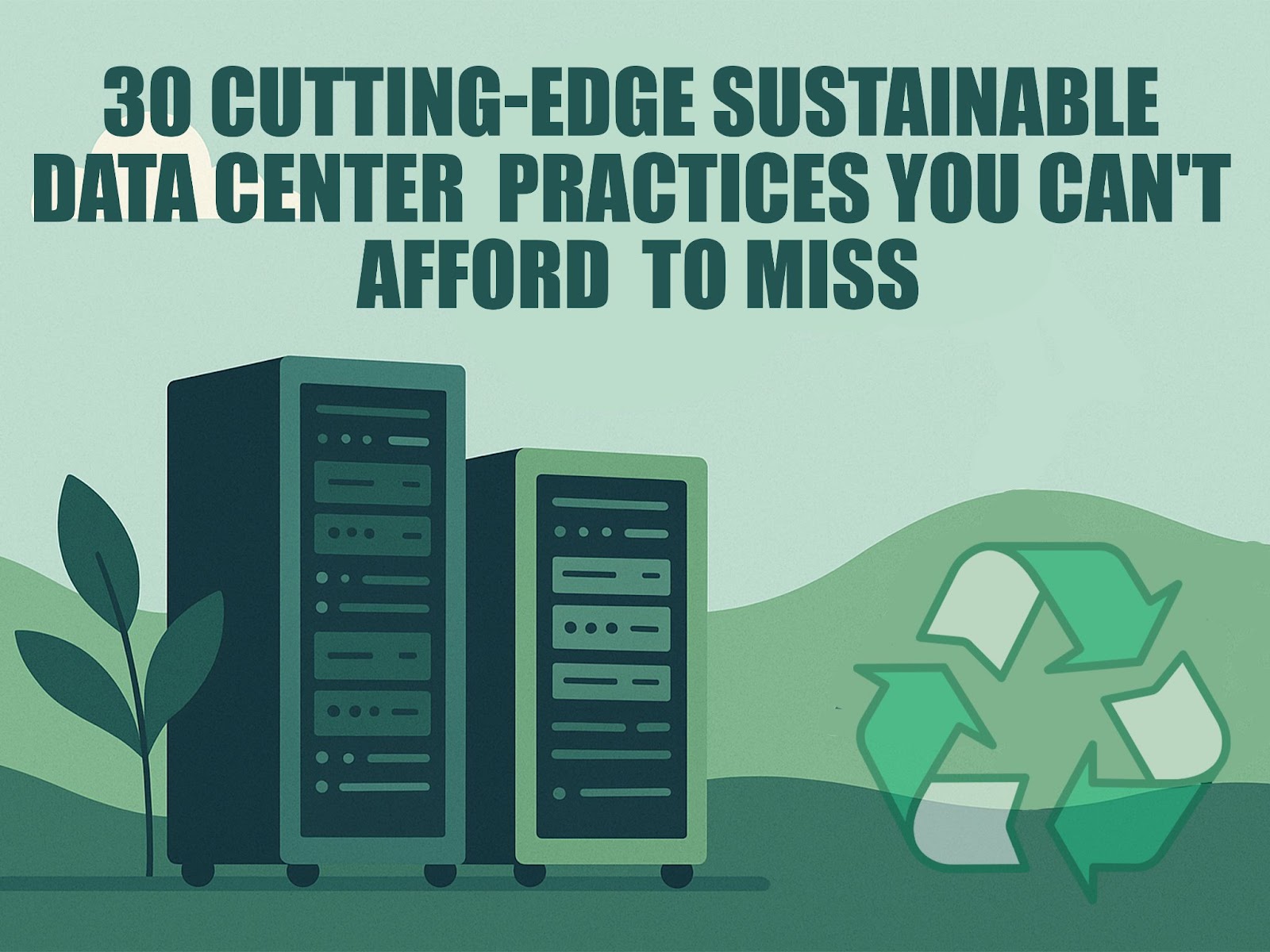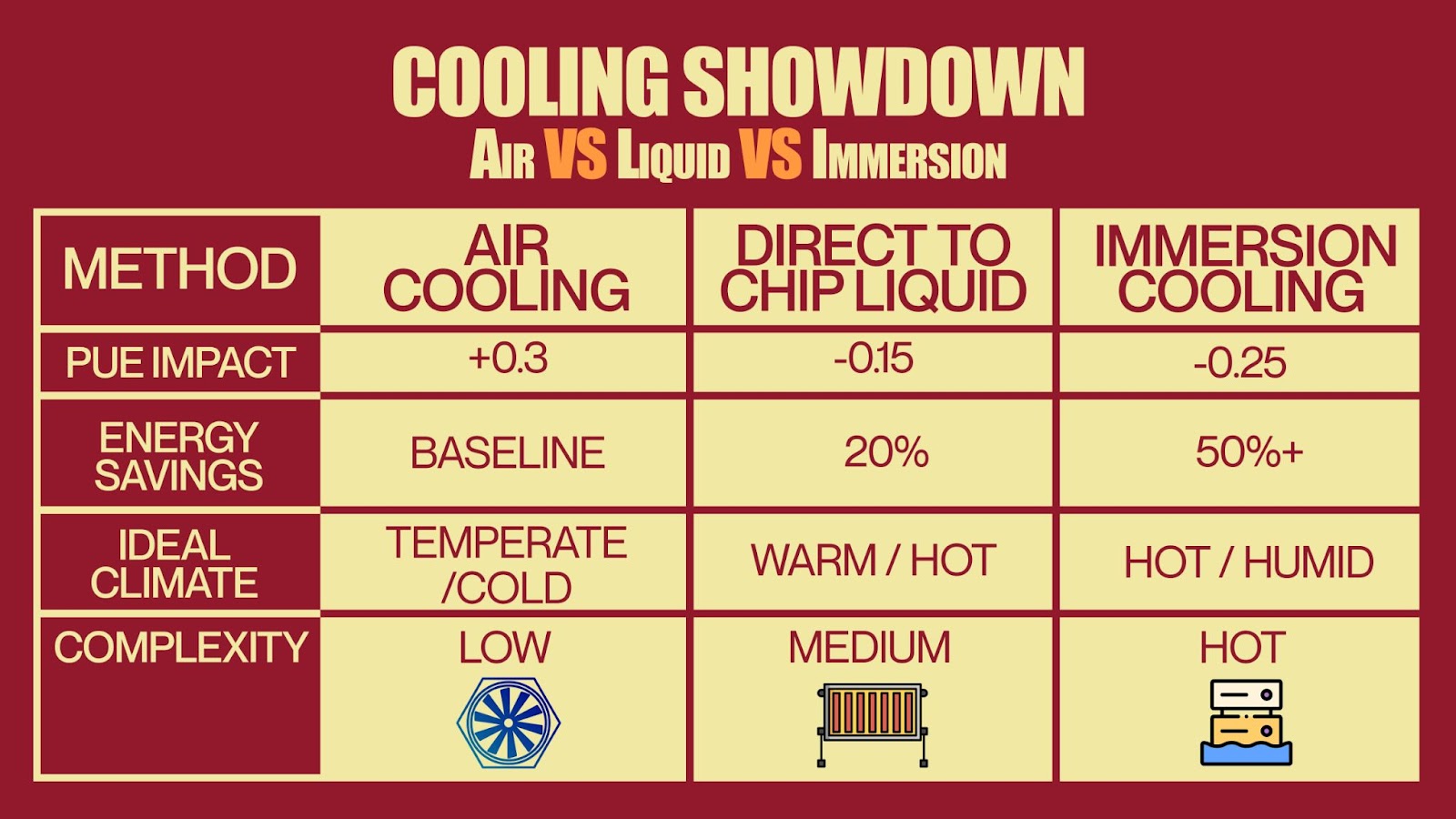
Modern data centers consume massive amounts of electricity—up to 2% of global power and often rely on coal or gas. This drives up costs and climate change. As digital services expand, energy demand will spike, straining grids and inflating carbon footprints. Sustainable Data Center Practices
Imagine frequent blackouts, increasing utility bills, and regulatory fines for high emissions. Water scarcity may force shutdowns of traditional air-cooled systems—electronic waste mounts when legacy hardware is replaced instead of being repurposed. Companies risk reputational damage, investor backlash, and missed sustainability targets without change.
Sustainable Data Center Practices offer a roadmap: AI-driven cooling, circular thermal loops, renewables integration, and rigorous lifecycle management. These strategies can cut energy usage by up to 60%, reduce carbon emissions, and deliver 20–30% cost savings over five years.
Ready to transform your operations? Contact us for a free comprehensive sustainability audit and roadmap.
Introduction to Sustainable Data Centers
Defining Sustainable Data Center Practices: Sustainable data center practices contain any method that lowers environmental impact across planning, construction, and operations. This includes:
- Hardware Optimization: Low-power CPUs and efficient memory modules.
- Energy Management: AI-driven load balance and predictive cooling.
- Renewable Integration: On-site solar, PPAs, and battery storage.
- Lifecycle Strategies: LCA analysis, e-waste recycling, and circular economies.
Why They Matter
- Energy & Carbon Footprint: As data centers scale, emissions could rise to 8% of global CO₂ by 2030. Sustainable practices curb this trend, aligning with corporate net-zero goals.
- Regulatory Landscape: Stricter regional mandates—like the EU’s Green Deal and California’s water reuse rules—demand proactive compliance.
- Cost Efficiency: Energy bills can represent 30–40% of a data center’s OPEX. Efficiency measures yield significant ROI within 3–5 years.
- Brand & Investor Relations: Sustainability ratings by CDP and the Dow Jones Sustainability Index influence investor decisions.
By embedding Sustainable Data Center Practices early—from site selection to decommissioning—organizations can future-proof infrastructure, meet stakeholder expectations, and drive long-term profitability.
Edge Computing Data Centers: Transforming the Future of Digital Infrastructure
Energy Efficiency Innovations
Efficient Server Design and Hardware Optimization
- Low-Power Processor Architectures: Next-generation processors from Intel (Atom series) and AMD (EPYC series) deliver substantial energy savings through advanced sleep states and dynamic frequency scaling. These CPUs adjust voltage and clock speeds in real time, dropping power draw by up to 40% during idle periods.
- Modular Chassis & Component Reuse: Modular server blades allow hot-swapping of CPUs, memory sticks, and power supplies. Instead of replacing entire servers, operators can upgrade only outdated modules, reducing material waste and extending of lifecycle by up to five years.
- Energy-Aware Software Suites: Integration of intelligent software agents (e.g., PowerInsight, DCIM tools) monitors workload intensity and throttles unused cores. By combining hardware and software optimizations, data centers can shave off 15–25% of peak power draw, improving overall PUE.
Virtualization and Workload Consolidation
- Hypervisors & Containers: Software solutions like VMware vSphere, Microsoft Hyper-V, and Docker containers facilitate high-density deployments. Multi-tenant workloads run efficiently together, reducing the number of physical servers required by 60–70%.
- Dynamic Workload Scheduling: Tools such as Microsoft Azure Automanage and AWS Elastic Compute optimize VM placement across servers, throttling underutilized nodes and spinning down idle hosts. This dynamic consolidation yields up to 50% reduction in idle energy consumption.
AI for Predictive Cooling and Load Balancing
- Machine Learning Models for Thermal Analysis: Platforms like Schneider Electric’s EcoStruxure and Google DeepMind analyze temperature sensor arrays to forecast thermal hotspots hours in advance. The system automatically adjusts CRAC/CRAH unit speeds, reducing cooling energy by 30% without risking equipment damage.
- AI-Driven Workload Migration: AI agents evaluate server workloads and grid carbon intensity forecasts, migrating batch jobs to off-peak hours or cleaner energy regions. Google pioneered this approach, achieving a 5% reduction in global compute carbon footprint.
Cooling and Thermal Management

Liquid Cooling and Immersion Cooling
- Direct-to-Chip Liquid Cooling: Coolant flows through microchannels etched directly into cold plates mounted on CPU/GPU dies. This direct contact yields thermal transfer coefficients 10× higher than air, eliminating hot spots and allowing server inlet temperatures up to 45°C, reducing chiller loads.
- Immersion Cooling: Servers submerged in dielectric fluids (e.g., 3M Novec, mineral oil) experience uniform cooling, enabling rack densities over 500 kW. Data centers employing two-phase immersion have reported energy savings of 50–70%, drastically cutting PUE values.
Free Cooling and Outside Air Systems
- Air Economizer Configurations: In cooler climates, air economizers draw in outside air through HEPA filters and pre-cool coils. Humidity control via enthalpy exchangers prevents condensation, ensuring reliable operation even in humid seasons.
- Dynamic Damper Control: Automated dampers respond to real-time temperature and particulate sensor data. When external conditions are favorable, dampers open fully, supplying up to 80% of cooling needs without mechanical chillers.
Heat Reuse and Circular Thermal Systems
- District Heating Integration: Excess heat channeled into local heating networks can supply residential or commercial buildings. Finnish data centers feed district heating loops that heat thousands of homes, offsetting local gas consumption.
- On-Site Applications: Vertical farms, greenhouses, and absorption chillers convert waste heat into cooling for auxiliary facilities. A Dutch facility uses this method to maintain year-round greenhouse operations, cultivating produce entirely on waste heat.
Renewable Energy Integration
On-Site Renewable Energy Generation
- Solar PV and BIPV: Building-integrated photovoltaics (BIPV) on facades and rooftops deliver up to 20–30% of peak load. Solar tracking arrays boost yield by up to 25%. Integrating smart inverters and edge controllers coordinates solar production with building loads.
- Wind Turbines & Hybrid Microgrids: Small-scale wind turbines (10–100 kW) installed on-site supplement solar. Combined with solar, these form hybrid microgrids managed via advanced EMS (Energy Management Systems), ensuring stable, carbon‑light power delivery.
Power Purchase Agreements (PPAs)
Physical vs. Virtual PPAs
- Physical PPAs: Direct energy off-take from a specific renewable project. Ideal for large campuses.
- Virtual PPAs: Financial contracts tied to off-site renewable generation. Companies claim environmental attributes while utilities handle physical delivery.
Structuring a PPA Key clauses include fixed price guarantees, production guarantees, and termination conditions. Well-negotiated PPAs stabilize energy budgets and provide valuable renewable energy certificates (RECs).
Energy Storage and Grid Resilience
- Battery Technologies Lithium-titanate batteries offer high cycle life for frequent charge/discharge, while flow batteries excel at multi-hour storage. Paired with solar, they shift excess midday generation to evening loads.
- Resilience Strategies Microgrid controllers orchestrate seamless transitions between grid, battery, and backup gensets. Regular island-mode drills validate backup procedures, ensuring uptime even during prolonged outages.
Ready for net-zero? Collaborate with our sustainability specialists to design, implement, and certify your next-generation green data center.
Carbon Reduction Strategies
Life Cycle Assessment (LCA) for Equipment
Use LCA methodologies to evaluate environmental impact across five phases: raw materials, manufacturing, shipping, usage, and end-of-life. Collaborate with OEMs to obtain precise upstream data. Use tools like OpenLCA to generate detailed carbon profiles for each hardware component. Benchmark LCA results annually to track procurement improvements and set science-based targets.
Carbon Offsets and Renewable Energy Credits (RECs)
After maximizing on-site efficiencies, offset residual emissions with certified carbon credits and RECs. Choose projects with high additionality such as forest conservation, methane capture, or new wind farms. Retire credits in public registries annually to maintain transparency. Balance offset purchases with ongoing efficiency investments for sustained decarbonization.
Case Study: Google & IBM Carbon Goals
Google: Matches 100% of global energy use with renewables, leverages DeepMind AI to optimize cooling, and is piloting carbon‑free energy procurement on an hourly basis by 2030 citeturn0news1.
IBM: Reduced emissions by 55% since 2005, targets 75% reduction by 2025, and employs closed‑loop water systems alongside LCA‑guided hardware procurement citeturn0news2.
Sustainable Architecture and Infrastructure
Green Building Design and Materials
Pursue LEED Platinum or BREEAM Outstanding by incorporating recycled steel, fly-ash concrete, and low-VOC finishes. Integrate green walls for natural insulation, reducing HVAC loads, and design for passive daylighting to cut lighting energy by 40%. Utilize building information modeling (BIM) to simulate energy performance during design.
Modular and Edge Data Centers
Modular units prefabricated in factories reduce on-site waste by 60%. Edge micro data centers (<50 racks) sit closer to end-users, cutting network latency and energy losses in transmission. These modules can incorporate localized free cooling and small PV arrays for added sustainability.
Water Efficiency and Wastewater Recycling
Implement closed-loop cooling distribution and condensate harvesting systems to capture and recycle up to 90% of water used in cooling towers. Treat graywater on-site for non-potable uses like landscaping, further cutting freshwater withdrawal.
How Edge Computing is Transforming AI-Powered Data Center Management?
Operations and Lifecycle Management
Equipment Recycling and E‑Waste Management
Partner with R2 and e-Stewards recyclers to shred hard drives and recover precious metals. Offer a client “take-back” program for decommissioned hardware, ensuring zero landfill waste and creating a circular supply chain.
Sustainable Vendor and Supply Chain Management
Create a vendor scorecard evaluating energy use, carbon targets, and packaging sustainability. Prioritize suppliers with ISO 14001 and zero-waste certifications. Negotiate green logistics contracts to minimize transport emissions.
Employee Training and Sustainability Culture
Host quarterly workshops, gamify power-saving behaviors, and display PUE dashboards in staff areas. Reward green champions with recognition and incentives to foster continuous engagement.
Monitoring, Certification, and Reporting
Sustainability Metrics and KPIs
Monitor PUE, CUE, WUE, and SUE (Server Utilization Effectiveness) via automated dashboards. Compare metrics against industry benchmarks and publicly report progress in sustainability reports.
Leading Certifications: LEED, ENERGY STAR, ISO 14001
Align design and operational procedures with certification requirements. Maintain documentation for audits and highlight achieved certifications in marketing materials.
Real-Time Monitoring Tools and Dashboards
Implement EcoStruxure, Vertiv Environet, or custom Grafana/Prometheus stacks to visualize real-time energy and environmental data. Use alerts to flag inefficiencies immediately.
China built hundreds of AI Data Centers To Catch The AI Boom | Reboot Monkey
Industry Benchmarks and Case Studies
Google’s Climate-Neutral Infrastructure
Google’s hyperscale data centers deploy DeepMind-driven cooling, on-site solar arrays, and hourly renewable matching to achieve industry-leading PUEs of 1.08 in temperate sites. Their innovative approach includes pilot carbon‑free energy procurement projects aiming for full implementation by 2030 citeturn0news3.
IBM’s Green Leadership in Data Centers
IBM retrofitted its Armonk and Poughkeepsie campuses with efficient chillers, closed‑loop water systems, and modular layouts. These upgrades cut water usage by 45% and energy use by 30% since 2018 citeturn0news4.
Other Industry Success Stories
- Facebook: Indirect evaporative cooling at its Luleå, Sweden center cut chiller runtime by 90%, slashing energy use and emissions drastically.
- Microsoft: Underwater Project Natick prototypes leverage ocean thermal conditions for passive cooling, reducing PUE to as low as 1.07 in trials.
- Alibaba: Deploys AI-driven workload scheduling paired with solar integration in its Zhangbei data hub, achieving a 20% carbon footprint reduction.
Trends and Future Outlook
AI-Driven Sustainability Forecasting
The next wave of Data center sustainability trends centers on predictive analytics. Advanced ML models will ingest weather forecasts, grid carbon-intensity data, and real-time PUE metrics to optimize workload placement and cooling setpoints dynamically. Companies like Google and AWS are piloting hourly carbon matching, shifting non-critical tasks to periods with cleaner grid energy. Future dashboards will blend forecasting with automated control, driving further gains in both performance and sustainability.
The Rise of Edge and Micro Data Centers
Decentralized Sustainable Data Center Practices are exploding in edge computing. Micro data centers—compact modules housing up to 50 racks—enable organizations to process data closer to users, slashing latency and transmission losses. These units often integrate localized free cooling, small solar arrays, and liquid cooling loops, creating highly efficient, low-footprint operations that complement hyperscale facilities.
Policy and Global Initiatives
Global initiatives like the EU’s Green Deal mandate 100% renewable energy for new data center builds by 2030. California’s Title 24 updates require advanced water recycling for all large tech facilities. Voluntary pacts—RE100 and the Climate Neutral Data Centre Pact—urge members to hit net-zero power consumption and disclose PUE and carbon metrics publicly. These policies accelerate the adoption of Data center sustainability certification and push the entire industry toward greener horizons.
Conclusion
In an era where digital growth and environmental stewardship must coexist, these 30 Sustainable Data Center Practices provide a clear pathway. From hardware and cooling innovations to renewable energy, carbon reduction strategies, and forward-looking trends, each chapter outlines actionable steps to reduce costs, enhance resilience, and drive corporate sustainability goals. By adopting these best practices, organizations not only comply with emerging regulations and satisfy stakeholder demands but also future-proof their critical infrastructure against the evolving demands of tomorrow’s digital landscape.
Transitioning to green operations requires commitment and collaboration across vendors, engineers, and executives. Start today by benchmarking your current PUE, identifying quick-win efficiency gains, and charting a multi-year roadmap toward carbon neutrality.
Don’t wait for regulations to force change. Partner with us to develop and implement a tailored green data center strategy.
Frequently Asked Questions
What are Sustainable Data Center Practices?
Sustainable Data Center Practices are eco-friendly strategies that lower energy use, reduce carbon emissions, and optimize resource efficiency in data center operations.
Why are Sustainable Data Center Practices important?
They cut operational costs, ensure regulatory compliance, and help organizations meet net-zero goals while driving long-term infrastructure resilience.
How can I start implementing Sustainable Data Center Practices?
Begin with an energy audit to identify inefficiencies, then prioritize quick wins like virtualization and AI-driven cooling before integrating renewables.
What metrics measure the success of Sustainable Data Center Practices?
Key KPIs include Power Usage Effectiveness (PUE), Carbon Usage Effectiveness (CUE), and Water Usage Effectiveness (WUE) for tracking improvements.
Where can I get resources on Sustainable Data Center Practices?
Download our comprehensive Sustainable Data Center Practices PPT or contact experts for customized guidance and implementation roadmaps. citeturn0news4


Comments
2 responses to “The Future is Green: 30 Cutting-Edge Sustainable Data Center Practices”
[…] The Future is Green: 30 Cutting-Edge Sustainable Data Center Practices […]
[…] The Future is Green: 30 Cutting-Edge Sustainable Data Center Practices […]